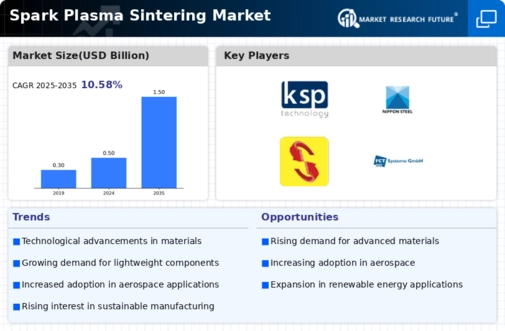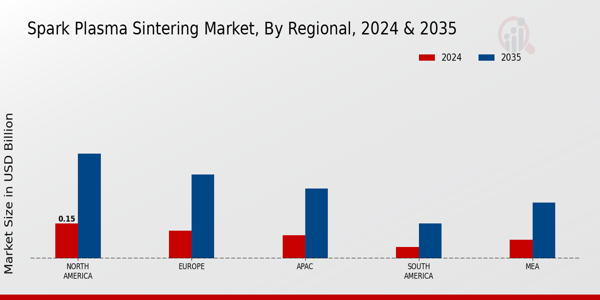Technological Advancements
The Global Spark Plasma Sintering Market Industry is experiencing rapid technological advancements that enhance the efficiency and effectiveness of the sintering process. Innovations in equipment design and control systems are enabling manufacturers to achieve superior material properties and reduced processing times. For instance, the introduction of real-time monitoring systems allows for precise control over temperature and pressure, which is crucial for optimizing sintering outcomes. As a result, the market is projected to grow from 0.5 USD Billion in 2024 to 1.5 USD Billion by 2035, reflecting a compound annual growth rate of 10.5% from 2025 to 2035.
Expansion of Application Areas
The expansion of application areas for spark plasma sintering is a notable driver of the Global Spark Plasma Sintering Market Industry. This technology is finding applications beyond traditional sectors, including biomedical, energy, and electronics. For example, the ability to produce biocompatible materials for medical implants is gaining traction, as healthcare providers seek innovative solutions. Additionally, the energy sector is exploring the use of spark plasma sintering for producing advanced materials for energy storage systems. This diversification of applications is likely to enhance market opportunities, leading to sustained growth in the coming years.
Rising Demand for Advanced Materials
The demand for advanced materials in various industries is a significant driver for the Global Spark Plasma Sintering Market Industry. Industries such as aerospace, automotive, and electronics are increasingly seeking materials with enhanced mechanical properties, thermal stability, and lightweight characteristics. Spark plasma sintering facilitates the production of complex geometries and high-performance materials, which are essential for meeting these industry requirements. The growing emphasis on lightweight components in automotive applications, for example, is likely to propel the adoption of spark plasma sintering technologies, thereby contributing to market growth.
Sustainability and Eco-Friendly Practices
Sustainability concerns are becoming increasingly prominent in manufacturing processes, influencing the Global Spark Plasma Sintering Market Industry. Spark plasma sintering is recognized for its energy efficiency and reduced waste generation compared to traditional sintering methods. This eco-friendly approach aligns with global initiatives aimed at minimizing environmental impact. As industries strive to adopt greener practices, the appeal of spark plasma sintering is likely to increase, driving market expansion. Companies that leverage these sustainable practices may gain a competitive edge, further fueling the growth of the market.
Growing Investment in Research and Development
Investment in research and development is a crucial factor propelling the Global Spark Plasma Sintering Market Industry. Governments and private entities are increasingly funding R&D initiatives to explore new applications and improve existing technologies. This investment not only fosters innovation but also enhances the overall competitiveness of the industry. For instance, collaborative efforts between academic institutions and industry players are leading to breakthroughs in material science, which could expand the scope of spark plasma sintering applications. As a result, the market is expected to benefit from these advancements, contributing to its projected growth.
















Leave a Comment